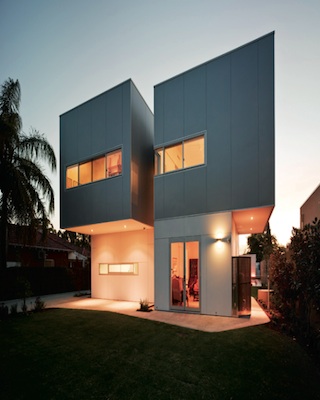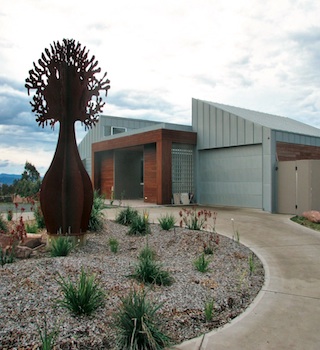 Q-TWO HOUSE
Q-TWO HOUSE
SUBMITTED BY CLEVER DESIGN
The design of the Q-Two House was to create a contemporary home, with light filled spaces that integrated sustainable design principles, with the ability to also be carbon neutral into the future.
INITIATIVES:
-
designed with passive solar and energy efficiency principles rigorously applied with a northern orientation, and zoning for maximum thermal performance for Climate Zone 7 (cool temperate)
-
bunkering the home deep into the steep quarry site
seemingly giving the appearance of emerging from the hillside and, at the same time, connecting to its natural environment with minimal disturbance to habitation
-
design exceeds BCA Energy Efficiency Provisions for Tasmania - Climate Zone 7 with a Star Rating of 6.0
-
40 tube Apricus solar hot water system, roof mounted at 43o pitched and connected to 315 litre ‘Everlast’ stainless steel hot water cylinder
-
the home is also hardwired for future connection to photovoltaic system
 DALKEITH RESIDENCE
DALKEITH RESIDENCE
SUBMITTED BY IREDALE PEDERSEN HOOK ARCHITECTS
Approved by BCA Self Assessment, the Dalkeith Residence has the look and feel of a traditional Queensland dwelling. The architects had an emphasis on revamping the gardening, and an introduction of photovoltaic cells to the house to ensure the client’s sustainability needs were met.
INITIATIVES:
-
the project was approved via the BCA Self Assessment
-
roof mounted photovoltaic cells provide power while
consumption is minimised with compact and T5
fluorescent light fittings and low energy fixtures
-
the parasol roof, PV cells and hot water system shade the roof to reduce heat load while
allowing cool air to filter
-
the house is constructed from plantation pine and the cantilevers with plantation plywood
-
cooling is provided by shallow water ponds placed between pavilions with low and high level
windows directing chilled air through all parts of the house
 WILKS RESIDENCE
WILKS RESIDENCE
SUBMITTED BY ATELIER HAEFELI
Atelier wanted to create a ‘village context’ feel, being in a rural location, self sufficiency was on top of list requirements in the brief.
INITIATIVES:
-
the responding ‘courtyard house’ has four main courtyards coinciding with the sun's path
-
use of renewable energy and materials as well as the design of buildings
-
electricity is 4.9 kw windmill and 4.3 kw photovoltaic; both connected to grid
-
all roofs are connected to 3 x 26k litre tanks
-
sewerage: blackwater 5k bioseptic treatment grey
water used for plant irrigation
-
a star rating of 6.9 stars using the Accurate program
-
hydronic floor heating and cooling system, driven
by solar thermie roof panels, keeps the house very comfortable, without A/C
 PENOLA HOUSE
PENOLA HOUSE
SUBMITTED BY POSITIVE FOOTPRINTS
The brief was to build an imaginative and ecologically sustainable home for a couple who are environmental and social justice advocates with a three year old son.
INITIATIVES:
-
the design seeks to take a holistic passive solar approach in making the most of the natural resources and energy flows available to the site
-
the house achieves a 9.1stars with the Accurate House Energy Rating software
-
passive solar design, further interrogated and improved using the Accurate Software
-
installation of a Greenswitch to turn off standby loads before going to bed/leaving the house
-
6k litre Rainwater tank to run laundry, flush toilets, and surface-water garden
THE MOORINGS
SUBMITTED BY WOODSTOCK BUILDING
The brief was to create a ‘lake style’ house with the axis of the house aligning with the existing jetty, incorporating recycled hardwood recovered from the White Bay coal loader in Sydney.
INITIATIVES:
-
the client was a retired couple from Sydney
-
4.5kw grid interactive solar array
-
the project cost approximately $2,0000
per sqm
-
northern windows in vaulted ceiling
allow for light entry to southern side of house, abundant cross ventilation, use of deciduous vine of pergola to create seasonal shade
-
recycled water system , solar hot water , ceiling fans and grid interactive solar power were used
-
grey water from bathrooms and laundry were recycled for watering the garden recycled hardwoods were used for feature timber work such as entry door and vanity units
 WING HOUSE
WING HOUSE
SUBMITTED BY COPRAXIS ARCHITECTS
The project is an affordable, environmentally sustainable project in regional Western Australia. It was designed to provide an example of how the project market can take on new paradigms in ESD, without compromising competitiveness.
INITIATIVES:
-
the building has taken into account, not only the northern aspect but the fact the sun rises and sets at different orientations throughout the years and used the building geometry to generate additional shading on summer mornings and evenings
-
6.5 stars ABSA rating
-
thermal design addressed energy efficiency
-
grey water was implemented
-
project acknowledges horizontal tracking of the sun through the seasons as well as vertical tracking
• used plantation timber for the frames for the main building system, and incorporated a water tank into the structure of the building
 PARADISE HOUSE
PARADISE HOUSE
SUBMITTED BY HATZ
Capturing ocean views, the idea was to provide an insulated thermal body, both internally and externally. The sleek design also utilises on site sewerage treatment via a septic tank with a pressurised soakage bed which minimises disruption to native scrub. Rainwater was also captured on site and delivered to a 20,000L below ground water tank.
INITIATIVES:
-
the living spaces use Low E glass to reduces heat gain and increases heat retention throughout winter
-
5 Star rating using AccuRate
-
provides an insulated thermal body, both internatlly and externally,
to reduce reliance on mechanical heating and cooling systems
-
rainwater is captured on site and delivered to a 20,000L below
ground water tank which redistributes the water to both the laundry and toilets.
-
the heating and cooling of the house is locally zoned, room by room
-
the fixed and double hung external glazing on the north and western facades are Pilkington IGU
Glass using 5mm clear toughened inside with a 12mm air gap and a 6mm clear Eclipse Advantage toughened outside layer
A TRULY SUSTAINABLE HOME
SUBMITTED BY AUSTRALIAN LIVING (ARCHITECT: PIDCOCK - ARCHITECTURE + SUSTAINABILITY)
This home was developed as part of Australian Living’s Eco-Challenge in which four families and four architects were challenged to design and construct four sustainable homes in Rose Bay NSW.
INITIATIVES:
-
3 kW photo voltaics for energy generation
-
3X 2200 litre water tanks, connected to toilets, washing machine and landscape
-
recycled timber for courtyard structure, decking, cladding and stairs
-
the University of New South Wales is currently using this house to research the accuracy
of the thermal comfort simulation
-
recent air quality test showed that the home has extremely low VOC levels and
carbon monoxide
-
an 8 star rating was achieved for the potential thermal performance of the house
+%7c+Architecture+%26+Design&pu=/awards-1/past-awards/bpn-sustainability-awards-2011-single-dwelling-new&pt=_Article)
+%7c+Architecture+%26+Design&pu=/awards-1/past-awards/bpn-sustainability-awards-2011-single-dwelling-new&pt=_Article)